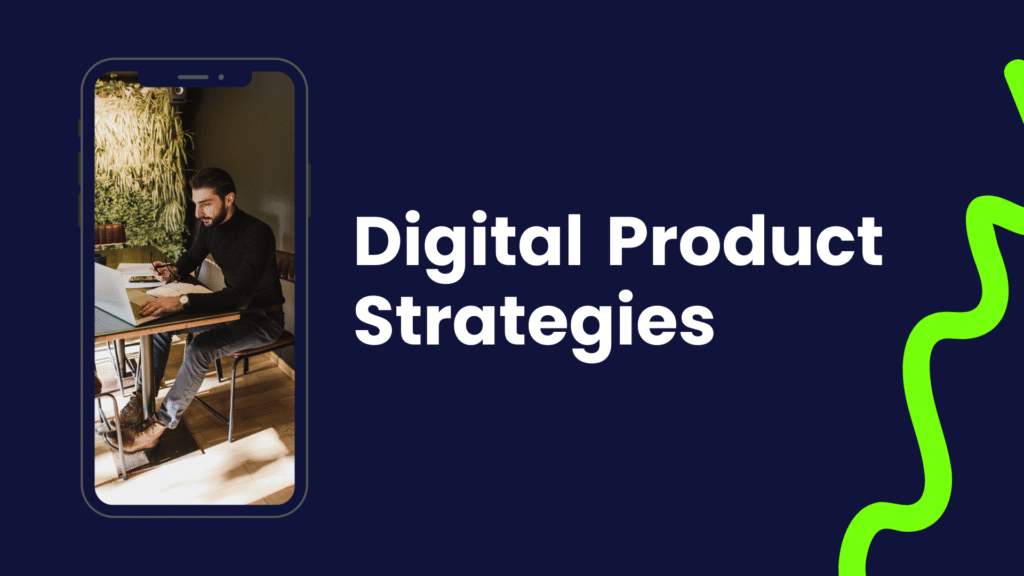
Introduction
Digital products have transformed business operations by enabling new methods for creating value while delivering products and scaling businesses efficiently. Digital products that include SaaS platforms and downloadable assets, together with online courses, remove inventory expenses and enable worldwide access. Successful digital products require a strategic approach to development beyond the code and design phases. This guide serves digital creators and startups, as well as B2B manufacturers who seek to develop and expand digital products that deliver outstanding performance. This course teaches you to develop strategies that support continuous growth and sustainable success within digital marketplaces.
What Is Digital Product Strategy? A Game-Changing Breakdown
A digital product strategy describes how a digital solution will fulfill its users’ needs and support wider business objectives. Its scope extends past design and marketing to cover a complete lifecycle process from initial idea development to final product delivery while integrating research efforts, design work, technological advancements, and growth strategies.
The core elements of a digital product strategy include:
- Vision and long-term objectives
- Understanding user needs and behaviors
- Market positioning and competitive analysis
- Cross-functional alignment between teams
- Metrics and KPIs for continuous evaluation
McKinsey research indicates that businesses implementing strong digital strategies achieve revenue growth 1.5 times greater than companies lacking such strategies. This statistic demonstrates how a clear strategy delivers real business benefits.
Implementing a digital product strategy means making an ongoing pledge to innovate beyond just having a plan. The strategy aligns various teams to work together around common objectives while maintaining efficient resource use and producing measurable results. The connection between vision and execution relies on strategy.
Mastering Digital Product Strategy for Explosive Online Success
Successful strategy development involves integrating market research findings with user psychology insights and business expertise. Begin your analysis by understanding your product’s primary function and its role in the wider market ecosystem. Your product mission and value proposition must be communicated clearly.
Develop measurable KPIs that showcase your product’s achievements. Key metrics to measure product success include monthly recurring revenue (MRR), user engagement statistics, customer retention rates, and net promoter score (NPS). Your team can use these metrics to measure success at every stage of the product lifecycle.
Customer-centricity should drive every decision. Utilize user interviews and surveys together with behavioral analysis to determine your users’ essential needs. Businesses can adopt predictive and adaptive strategies based on insights, which allows them to navigate market changes with assuredness.
Adobe’s Creative Cloud transition to a subscription-based model, which incorporated user feedback and market trends, generated more than $10 billion in revenue in the year 2023. The transition showcases the effectiveness of synchronizing product strategy with consumer actions.
Product teams need to continually update their strategy documents to stay aligned with evolving market conditions and technological advancements. Business strategies must remain adaptable because yesterday’s successful approach may fail tomorrow.
The Ultimate Guide to Digital Product Design and Strategy That Converts
Design and strategy must operate in unison. Design encompasses both the appearance of a product and the way it works to provide an enjoyable experience for users. A successful design strategy achieves attention capture while also securing user retention through seamless and intuitive interactions.
Short design cycles coupled with iterative prototypes and user testing serve to minimize risks associated with your investments. Digital design tools such as Figma, Sketch, and Adobe XD promote quick teamwork and feedback exchanges, which enhance decision-making efficiency and shorten product release durations.
Your product must offer accessibility on different devices and platforms. Product design decisions need to mirror the actual conditions and constraints faced by users. A winning user experience emerges from maintaining consistent layouts alongside clear calls-to-action and intuitive navigation paths. As design processes become more refined over time, they lead to better conversion rates and stronger brand perception.
Good design also communicates trust. Professionalism and reliability established through polished and consistent design directly affect how users make purchasing decisions. The strategic advantage emerges from the interplay between aesthetics and usability.
Winning with the Best Digital Product Strategy Framework for 2025
A strategy framework functions as a blueprint for building and launching digital products and then scaling them effectively. The Lean Startup, Agile, and Jobs-to-be-Done frameworks provide a strategic structure to both decision-making processes and operational execution.
Choose the right framework by considering:
- Product maturity (idea vs. scale stage)
- Team size and dynamics
- Customer research methodology
The Agile methodology enables rapid iteration cycles and continuous improvement, which makes it perfect for SaaS products. JTBD helps reveal fundamental user motivation, which provides value in competitive industries. Lean Startup methodology focuses on developing MVPs while validating concepts to minimize waste and promote experimental approaches.
Here’s a comparison table of common frameworks:
| Framework | Best For | Strengths |
| Agile | Ongoing product development | Fast feedback, user-centric |
| Lean Startup | Early-stage startups | MVP testing, rapid validation |
| JTBD | Understanding user motivations | Deep customer insights |
Organizations can achieve optimal results by combining elements from different frameworks since they do not operate independently. Customizing framework elements to match your product lifecycle stage enables better adaptability and effectiveness.
How to Create a Powerful Digital Product Design Strategy That Sells
A successful design strategy requires a harmonious blend of creative elements and practical functionality. Start by conducting thorough market and user research to discover current gaps. Journey mapping enables designers to see user interactions with their product and identify potential problem areas.
Start by developing low-fidelity wireframes for testing structure and logic before advancing to high-fidelity prototypes that simulate real usage. Conduct usability tests with real users at every development phase to verify the practical validity of your assumptions.
User expectations align more closely with product features through each iteration cycle. The best design strategy transforms user friction points into smooth interactions, leading to straightforward conversion. Your product requires ongoing evaluation of design performance against business KPIs to maintain its relevance as it expands.
The blueprint of a robust design strategy encompasses a plan to scale. Your design system requires scalability to accommodate larger user bases while maintaining strong performance and user experience. Planning for growth is designing for success.
How to Present Your Digital Product Strategy Like a Pro
An effective presentation of your strategy ensures both stakeholder approval and effective team direction. Start with a clear narrative: Which problem does your solution address, and who benefits from it? Outline your vision and key goals.
Explain your execution plan in phases:
- Research and discovery
- Design and prototyping
- Development and launch
- Growth and optimization
Incorporate roadmaps, mockups, and data charts to improve the clarity of your presentation. The power of storytelling comes from its ability to connect every point with a direct business impact. Focus on projected ROI projections and customer value implications to reinforce your argument.
Tailor your presentation to the audience. Executives require high-level ROI projections, but designers and developers need precise task details and timelines. Prepare additional data and examples to respond to any questions or concerns.
When strategies are presented clearly, they generate understanding alongside unity and forward movement. Teams receive the ability to perform their tasks with both confidence and precision.
Discovering Proven Methods for Massive Digital Product Growth
Growth isn’t accidental—it’s engineered. Steady growth of digital products requires ongoing experimentation and measurement followed by strategic optimization. Achieving digital product growth requires strategic marketing alongside product development alignment.
Your growth strategies must be customized to match both your product category and intended audience. The success of digital product growth relies heavily on community building, content marketing, and referral programs. Incorporating customer feedback loops allows for continuous iteration that leads to improved solutions.
Key growth tactics include:
- Leveraging customer feedback to improve features
- Implementing performance-based marketing campaigns
- Improved user experience functions as a vital tool for maintaining customer engagement and preventing user attrition.
According to Mixpanel, products that utilize optimized onboarding processes achieve activation rates that are 50% higher than other products. The design of onboarding processes stands out as a fundamental element for driving business growth.
User lifecycle analytics serve as a foundation for achieving sustainable growth. Insight into user behavior from initial discovery through conversion to advocacy helps organizations make better decisions and allocate resources more effectively.
B2B Manufacturing Marketing Strategy: Fueling Digital Product Domination
By entering the digital product space, B2B manufacturers can generate new revenue streams and modernize their operational processes. Product configurators, along with simulation platforms and predictive maintenance software, represent digital tools that transform manufacturing sector operations.
Success depends on synchronizing digital product initiatives with operational goals. Success in this sector requires marketing strategies that demonstrate product value alongside reliability while showcasing monetary benefits. Emphasize measurable outcomes over flashy features.
Effective approaches include:
- Educational content marketing (e.g., webinars, whitepapers)
- Targeted outreach through LinkedIn and industry platforms
- Real-world case studies demonstrate the measurable advantages provided by digital tools.
Siemens achieved significant benefits in manufacturing by utilizing digital twins to achieve a 30% reduction in design errors and substantial cost savings. Proper marketing of digital tools demonstrates their ability to produce substantial ROI for industrial clients.
Building trust is crucial in B2B environments. To build trust, businesses must demonstrate performance results while maintaining clear and honest communications and illustrating their potential as long-term partners.
Conclusion
The development of a successful digital product involves more than just having a good idea because it requires a thorough strategic approach that spans from design to growth. Both solo entrepreneurs and B2B enterprises need structured digital product strategies to maximize their product success.
Establish clear objectives first and use empathy in your design while selecting appropriate frameworks and maintaining continuous optimization. Use strategic planning to establish your advantage in the digital marketplace. Testing new ideas, learning from outcomes, and iterating your approach will help you maintain a competitive position in the rapidly changing digital world.
Frequently Asked Questions (FAQs)
1. What makes a digital product strategy successful?
A digital product strategy succeeds when it matches user requirements with company objectives through well-defined goals and measurable KPIs alongside implementable plans.
2. How long does it take to develop a digital product strategy?
The duration required to develop the strategy fluctuates depending on complexity but generally spans between four to eight weeks to perform research and create a strategy document with defined goals.
3. Can small businesses benefit from digital product strategies?
Absolutely. Small businesses that create well-planned strategies can scale efficiently while reducing costs and competing against bigger companies.
4. What is the biggest mistake in digital product strategy?
The main error in digital product strategy emerges from not testing assumptions with data from actual users. The most brilliant ideas will fail without insights from users.
5. How do I know which strategy framework is right for me?
Your current development stage and team size combined with user understanding determine which strategy framework suits you best. Startups at the beginning stages gain advantages from Lean methods while established products perform best under Agile or JTBD frameworks.

